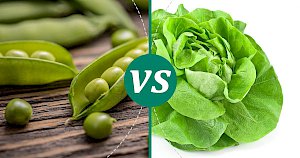Lettuce vs Peas: Calories & Nutrition Showdown


Lettuce vs Peas
Nutrition Facts
Serving size:
change
5g10g15g20g30g40g50g60g80g100g120g140g160g180g200g220g250g300g350g400g450g500g600g700g800g900g1000g
1oz2oz3oz4oz5oz6oz7oz8oz10oz12oz15oz20oz25oz30oz35oz40oz50oz
Amount Per Serving:
Serving size:
change
5g10g15g20g30g40g50g60g80g100g120g140g160g180g200g220g250g300g350g400g450g500g600g700g800g900g1000g
1oz2oz3oz4oz5oz6oz7oz8oz10oz12oz15oz20oz25oz30oz35oz40oz50oz
Amount Per Serving:
Lettuce vs Peas 100g Compare
| per 100g | Lettuce | Peas |
|---|---|---|
| Calories | 15 | 81 |
| Carbohydrates | 2.87 g | 14.45 g |
| Fat | 0.15 g | 0.4 g |
| Dietary fiber | 1.3 g | 5.7 g |
| Protein | 1.36 g | 5.42 g |
| Calcium | 36 mg | 25 mg |
| Iron | 0.86 mg | 1.47 mg |
| Magnessium | 13 mg | 33 mg |
| Potassium | 194 mg | 244 mg |
| Sodium | 28 mg | 5 mg |
| Vitaminium A | 7405 µg | 765 µg |
| Vitaminium B1 (Thiamine) | 0.07 mg | 0.266 mg |
| Vitaminium B2 (riboflavin) | 0.08 mg | 0.132 mg |
| Vitaminium B3 (Niacin) | 0.375 mg | 2.09 mg |
| Vitaminium B5 | 0.134 mg | 0.104 mg |
| Vitaminium B6 | 0.09 mg | 0.169 mg |
| Vitaminium B9 (Folic acid) | 38 mg | 0.065 mg |
| Vitaminium C | 9.2 mg | 40 mg |
| Vitaminium E | 0.29 mg | 0.13 mg |
| Vitaminium K | 126.3 µg | 0.025 µg |
| Beta karoten | 4443 mg | 449 mg |
Discovering the Nutritional Gems: Lettuce and Peas
When it comes to filling our plates with colorful, nutritious vegetables, lettuce and peas often make the list. Both of these vegetables are not only versatile and delicious but also come packed with a variety of nutrients essential for our health. Lettuce, with its crisp leaves, is a staple in salads worldwide, while peas, with their sweet flavor, can be found in everything from soups to stir-fries. But beyond their culinary uses, how do lettuce and peas compare nutritionally?
A Closer Look at Lettuce and Peas
Lettuce, particularly the green leafy variety, is well-known for its low calorie content, with just 15 calories per 100 grams. It's a great source of vitamins A and K, offering 7405 IU and 126.3 mcg respectively, which contribute to good vision, blood clotting, and bone health. Moreover, lettuce provides a modest amount of minerals like calcium and iron, and even packs a small protein punch.
Peas, on the other hand, are slightly more calorific, with 81 calories per 100 grams, but they bring a lot more to the table in terms of macronutrients. They're a good source of dietary fiber, essential for digestive health, and provide a significant amount of protein compared to lettuce. Peas are also rich in vitamins C and K, and minerals like magnesium, iron, and zinc, making them a nutritional powerhouse.
Nutritional Breakdown: The Details
- Calories: Lettuce has significantly fewer calories than peas, making it ideal for weight management.
- Protein: Peas offer more protein, which is crucial for muscle repair and growth.
- Fiber: With 5.1g of fiber, peas are a great option for improving digestive health.
- Vitamins and Minerals: Lettuce is a superior source of vitamins A and K, but peas provide more vitamin C, magnesium, iron, and zinc.
Both vegetables contain no cholesterol and are low in fat, making them heart-healthy choices. However, the higher fiber and protein content in peas make them more satiating, which can be beneficial for those looking to control their appetite and maintain a healthy weight.
Which One to Choose?
The decision between lettuce and peas ultimately depends on your nutritional needs and taste preferences. If you're aiming for a low-calorie option to bulk up your meals, lettuce is a perfect choice. Its high vitamin A content also makes it great for skin and vision health. On the other hand, if you're looking for a nutrient-dense vegetable that can provide a significant amount of protein and fiber, peas are the way to go. They can be a particularly good option for vegetarians and vegans looking to boost their protein intake.
Both lettuce and peas offer unique nutritional benefits, and incorporating a variety of vegetables into your diet is key to getting a broad spectrum of nutrients. So, why not enjoy the best of both worlds? A salad with crisp lettuce and sweet peas can offer a delightful combination of flavors and textures, along with a nutritional boost.
In conclusion, when it comes to comparing lettuce and peas, it's clear that both vegetables are nutritional champions in their own right. Whether you're crunching on a fresh lettuce salad or enjoying a hearty pea soup, you're doing your body a favor by including these nutrient-rich veggies in your diet.
Lettuce 100g
15kcalCalories source
- 63% CARBS.
- 30% PROTEIN
- 7% FAT
Peas 100g
81kcalCalories source
- 70% CARBS
- 26% PROTEIN
- 4% FAT
Compares of lettuce
- Lettuce vs Artichoke
- Lettuce vs Arugula
- Lettuce vs Asparagus
- Lettuce vs Pepper
- Lettuce vs Bok Choy
- Lettuce vs Broccoli
- see all compares of lettuce
Compares of peas
Read also:
- Calories from Lettuce
- Calories of Lima beans
- Calories in Lotus root
- Moringa calories per 100g
- Mustard greens protein per 100g
- How many calories does okra have?
- How Many Calories in Onion? A Guide to Onion Nutrition
- Calories in a half of parsnips
- Calories in whole parsnips
- Calories for one, two or more parsnips
- How much protein in peas?
Marcin Piotrowicz
calories-info.com creator
Healthy diet and healthy lifestyle promoter
Add comment